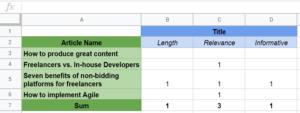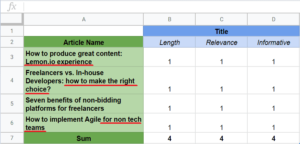Creativity is the most critical skill when it comes to producing great content. But creativity alone will not necessarily ensure your posts will be read. To reach the top, you must understand your target audience, closely analyze and emphasize your business’s strengths, and follow the
What is Content Analysis?
The content analysis comes originally from academia, where it is used to determine the intentions, purposes, and meanings of any type of communication (blogs, newspapers, podcasts, images, videos, etc.). It is achieved by evaluating the specific details, elements, and implications of the content.
In business, it is used to evaluate the produced content’s marketing effectiveness, define its weak and strong sides, and find out possible recommendations for its improvement.
Why is Content Analysis Important?
The latest research by Statista says that 4.33 billion people actively use the internet. They spend hours surfing and absorbing new information, which appears on their screens, mostly because Google algorithms said so.
It is not surprising that 91% of B2B and 86% of B2C businesses actively use content marketing to get to their client. And if your website is not one of them, you better catch up.
The results of a successful content analysis research can help you increase your website’s position on the search page, improve the content of your blog, and bring new clients.
How Does Content Analysis Work?
Where Should I Start?
In general, content analysis in business is an algorithm of actions that you need to increase the produced content’s effectiveness. The first step is to complete a little research on what potential problems you are looking for, what your content is mostly about, and who is interested in it.
As for the last one, at Lemon.io, we prefer to imagine our audience as a real person. We know what the reader’s occupation is, his favorite music genre, book, movie, superhero, what he dreams about, and what he wants for his business. That helps us define what our content should be about and how it should sound.
What’s Next?
The procedure of content analysis requires creating a scoring table. Usually, it is an Excel document, which includes the so-called categories and subcategories.
A category is something that describes a specific aspect of the article. A subcategory is a more precise characterization of a category. The more positive categories and subcategories are defined — the more successful the articles in the blog are.
To make it sound less complicated (it is much easier than it seems), let’s review an example below.

‘Title’ is a category. Title ‘length’, its ‘relevance,’ how ‘informative’ it is are subcategories. If the title length of the article you analyze is correct (we’ll talk about it later), mark ‘length’ as done (usually, I insert “1” ). If it is too long or too short, leave the cell empty. Next, if the title of your article is relevant, mark ‘relevance’ as done. If not, skip it. The same applies to the subcategory ‘informative.’
When you sum up all the “done” in the end, cells with smaller numbers indicate weak spots in your content. In our example, title length and informative level are lower than relevance. Therefore, to adjust the titles’ quality, we have to paraphrase them, making them longer and more informative. Here is an improved version of the titles:

How Do I Create a Scoring Table for the Content Analysis Research?
1. Include General Categories and Subcategories
Undoubtedly, every business requires a different scoring table. But there are a few basic categories suitable for everyone:
- Topic (subcategories: relevance, informative level, image content, outside resources);
- Appealing to the potential audience (subcategories: following the style, correct tone, formal or informal text, emotional level);
- The main goal (subcategories: informative, advertisement, expanding the audience).
The representation of these categories is determined by counting formal indicators of the content, such as specific phrases, images, data, links, emotional claims, etc.
Apart from the categories mentioned above, you have to search for more specific ones according to your business model and SEO strategy.
2. Define Categories Describing the Benefits of Your Business
Unique Services or Product
Marketing, in general, is about emphasizing your benefits over competitors. Even if you think there is nothing special that differs from them, you probably have to look deeper. Analyze your competitors, find their weak spots, and make them your strong sides.
For instance, our business aims to connect entrepreneurs with high-skilled freelance developers. We’ve spent weeks gathering information on our biggest competitors like Upwork, Freelancer, etc., and eventually found our super-power. Lemon is not just freelancers; it’s extra hands who respond fast and react efficiently.
Unique Content
The text you are posting cannot be plagiarised, so you need a plagiarism check. Before placing anything, run it through an anti-plagiarism system like Turnitin or Copyscape, especially if you accept guest posts.
But, your articles have to be unique by their ideas and fulfillment. Whatever you are writing about, try to make it more personalized and talk more about your own experience (even if it is not the most successful).
No Errors
I believe this point does not need to be precisely explained. Just check whatever you are writing for any mistakes. Nobody will take you seriously if you spell the word wrong or used an inappropriate term in a sentence. You can use Grammarly to correct your spelling, punctuation, and substitute words and phrases, which do not fit the context.
3. Complete SEO Content Analysis
Text Length
SEO content analysis starts with such a simple thing as the length estimation of your post. Different business goals require another word count. For example, if
However, if you aim to engage as many people in the conversation as possible (for example, you want to have 300 comments on social media), it’s better to write shorter texts of about 300 words.
Anyway, the length of the post is entirely up to you, but remember to set it according to your
Catchy Text Structure
The studies show that most people spend less than 15 seconds on the website before closing it. And once they do it, you will never see them again.
So, if you don’t want to lose your potential client, make sure to have a suitable text structure. Use headings for every section. Write no more than 3 or 4 sentences in a paragraph. Be straightforward in your explanations. Support your thoughts with credible data and sources.
Keyword Usage
Define keywords according to your topic and make sure to include them in the name of the article, meta description, headings, and, of course, in the paragraphs. It increases the chances of getting into the list of the highest-ranked websites by Google. But do not overuse it as it can add up badly. Texts overloaded with keywords are usually hard to understand.
This is the most tricky category. To analyze this category, we use Ahrefs. With this tool, we get information on the keyword difficulty estimation, its position in the search ranking, the number of links we need to get to achieve the top 10 search results, and the list of keywords used by competitors.
A more simplified tool for keyword analysis is the Keyword Density Checker. It helps determine the list of keywords on the URL page you submitted, search where they are located, and see if they correlate with the Headings.
Correct Title
In content analysis, it is necessary to overview everything, including the title of the article. According to the research by HubSpot, the optimal size of a title should be 70 characters. Usually, it is about 8-12 words. Not too short and not too long titles are informative enough and aesthetically more pleasant to see on the search page.
While completing the content analysis, you have to state if the title is relevant to what the article is about and make sure that it is catchy and interesting.
What Do I Get in the End?
As a result of the completed content analysis, you’ll have a table with each category’s exact number of observations. The lower the number is, the more chances that this is your weak spot in content production. Based on these numbers, you can:
- Complete an assessment of the marketing effectiveness of your blog’s content;
- Formulate new strategies to adjust your blog;
- Plan a new content placement strategy;
- Formulate perfect keywords to use for the website promotion;
- Search for opportunities to increase traffic and development.
One more thing to add: there is no perfect recipe for content analysis research. The categories we defined above can be changed under the specificity of your business model. Try to adapt content analysis and don’t stop experimenting with new strategies.
DepositPhotos – content analysis


